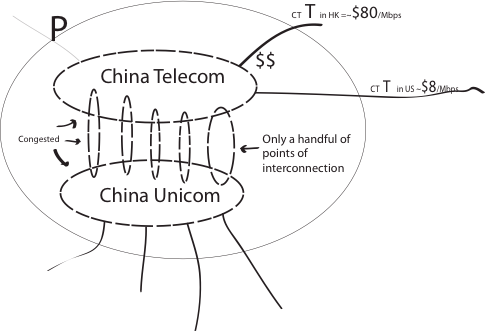My Blog
Q:
DrPeering –
What do you know about peering in China?
Anonymous
A:
Thanks for the note.
From and Internet Region perspective, China looks very much like every other Internet Region in the world; there are Tier 1 ISPs, Tier 2 ISPs and Content Providers that interconnect in business relationships to form their own Internet Peering Ecosystem.
The China Internet Peering Ecosystem
The Tier 1 ISPs in China peer with each other, and can reach any destination within the region solely through their free and reciprocal peering relationships. In China, the Tier 1 ISPs are China Telecom which dominates the north, and China Unicom formerly known as China Netcom, that dominates the south. They interconnect in a handful of places. As typical with Tier 1 ISPs, they peer with no one else inside their country. In this way, the China Internet Region is no different from any other Internet Region around the world.
So these two tier 1 ISPs essentially own the China Internet Peering Ecosystem.
Unfortunately, both of these networks are unreasonably congested, and are interconnected with one another in only a handful of places, which are also unreasonably congested.
Access to the China Internet Peering Ecosystem
While there are free peering possibilities, the capacity is too small and upgrade requests are met with a call from sales. Sound familiar? The salespeople will not upgrade the peering capacity unless you are purchasing paid peering or transit.
This is nothing new - I remember back when I chaired NANOG in the 1990’s ISPs were griping about how Sprint purposes under provisioned their peering capacity into MAE-East and upgrade requests were answered by sales people trying to sell high capacity access to Sprint customers instead. They were called out on it very publicly with no effect. Not to just pick on Sprint and the China Tier 1 ISPs - there are many other ISPs that have done the same maneuver. Nothing new for the playbook here.
The difference is that China can hardly be ignored in the future. (Sprint always had a ton of competition that pressured better interconnectivity. Not quite true in China.)
This is what makes this such a big potential problem in the Internet. China represents perhaps the largest set of connections to the Internet, and already presents such a large number of the congestion problems for these attachments. I predict that China will receive a lot more interconnect attention over the next couple of years; a lot of attention and much of the earth’s fiber and routers will be required to uncongest the China Internet Peering Ecosystem.
It is also interesting to hear some of the price points for getting access into China:
-
•To buy transit from China Telecom or China Netcom within the China borders might cost you $140 per megabit per second!
-
•But to buy transit to China from Hong Kong might costs closer to $80 per megabit per second.
-
•To buy transit from China telecom in the US might cost $8 per megabit per second.
It is counter-intuitive that the farther one gets away from China, the cheaper the price is for China Telecom transit! One would think that the closer you get to your destination, the cheaper it would be to get routes to it.
To explain why, I turn to my favorite quote from my work with John Milburn a few years back.
John Milburn said “The desire to protect one’s home market dwarfs any benefits that peering might provide.”
Think of it this way. If AT&T had cheap access to China routes from within China, then AT&T could start undercutting China Telecom’s in-country transit prices of $140/Mbps.Far better for China Telecom to make it cheap to access China from Los Angeles and cost prohibitive in country.
The next question that always comes up at this point is: “Well, couldn’t AT&T buy transit from CT in Los Angeles for $2/Mbps and sell access from within China?” Besides the other obstacles to operating within China, AT&T would also face performance problems. Customers of China Telecom (50%0 of the country) could access China Netcom customers (the other 50% of the country) through AT&T transit, but traffic would require two trips across the ocean to Los Angeles ! This “Asia Boomerang” prevents many serious attempts at selling transit within China.

China is a huge Internet market that has several barriers to entry. This brief highlights a couple collected from the field.
What up w/Peering in China?
April 25, 2012


The 2014 Internet Peering Playbook
In Print
and for the Kindle:
The PDF, ePub and
.mobi files are
also available as a
perpetually updated
DropBox share:
Price: $9.99
and in French!
The 2013 Internet Peering Playbook
also available for the Kindle:
and the ipad










